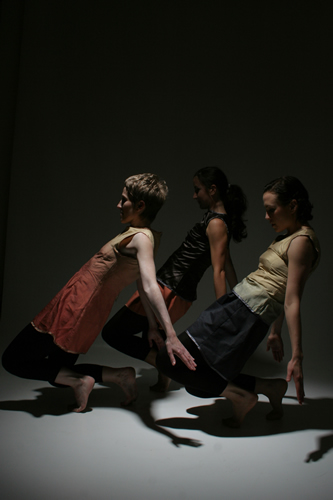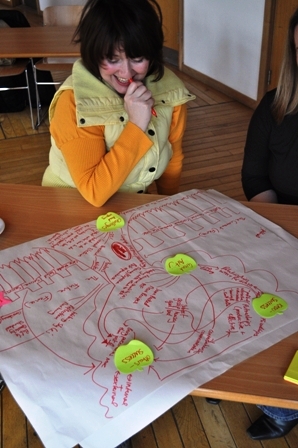
At the summit: national dance champions are among the many individuals, organisations and politicians making the case for culture
Loop Dance Company, photographed by Pete Fry
Culture, champions and politics
With a general election imminent, Gail Brown sifts through the promises made from a variety of platforms to review the evidence for political commitment to the arts.

At the summit: national dance champions are among the many individuals, organisations and politicians making the case for culture
Loop Dance Company, photographed by Pete Fry
The national dance summit on 23 February welcomed the UK national dance champions group and approximately 60 of the most influential London and regional dance and cultural innovators and leaders attended. Launched in October 2009, the group has a target of getting 100,000 more people dancing by 2012 and at the dance summit they were enthusiastic, open to discussion and curious as to how they can achieve this target and support the dance sector up to and beyond 2012.
With so much debate in the cultural sector at large, whether regarding future funding, supporting new talent or succession planning for creative leaders, the dance summit came at an opportune time. There are currently 4.8 million people participating in community dance each year, a total of 10,000 students are in training per year and the dance workforce is 40,000 people. Furthermore, dance is the second most popular physical activity for young people after football and the most popular physical activity for girls. There are also 50 professional dance companies in the UK, producing more than 500 productions every year, which are enjoyed by more than one million people. The current structure of dance highlights national and regional dance agencies, while Youth Dance England is embedding infrastructure for dancers across the generations. Arts Council England (ACE) is using the recent dance mapping research and leading a national arts debate and Big Dance has embraced a collective approach to national dance delivery, working with key organisations such as Foundation for Community Dance, the Central Council for Physical Recreation, the dance champions, Youth Dance England and the National Association of Local Government Arts Officers (Nalgao). Allan Davey, chief executive of Arts Council England continues to lobby for sustained investment in the arts. Dance UK is leading us by example, both in terms of joined-up approaches to political lobbying across the world and by embracing new approaches to supporting dance, such as working with the dance champions, as well as providing evidence to support the case for ongoing investment in dance and culture.
In the first nine days of March 2010 the National Campaign for the Arts (NCA) hosted three events. The first was a debate with the motion that “this country can no longer afford to subsidise the arts”. The controversial topic was debated by an audience of more than 200 people and the panel comprising playwright and author Bonnie Greer, Matthew Elliott of the Taxpayers’ Alliance, Simon Jenkins of the National Trust and Matthew Taylor from the Royal Society for the Encouragement of the Arts (RSA). The conclusion was that subsidised arts were financially viable as part of a mixed-economy approach to the arts which should include public subsidy, private investment, philanthropic giving and commercial activity. Bonnie Greer reminded the audience that “61 years ago this country made a stand and a promise to provide art to its citizens”. Standing in the midst of a recession with a general election imminent and facing some of the largest threats to investment in culture and art that the country has seen for quite some time, came as a poignant reminder to those working in the arts, politicians and indeed our champions.
The second NCA seminar focused on the general election and the not unsurprising story that it is a three- party race with the Liberal Democrats being the outsider to watch. The third event was the NCA’s London Art Hustings. Lib Dem MP Don Foster had reminded a recent arts audience that of every “£100 that the government spends in and on this country 7p of it goes to art and culture”. Foster also stated that it would be “economic madness and cultural vandalism to even think about cutting this”. Margaret Hodge, minister for culture, reminded the same audience that the DCMS art and culture budget is less than the Department of Health underspend. In this context it is worth remembering the point made by Martyn Allison, national adviser for culture and sport at the Improvement and Development Agency (IDeA), as part of the Nalgao/NCF seminar Outside In. Martyn pointed out that “if we attracted just 0.5% of the £145billion spent locally on health, children's services and adult care through [strategic] commissioning we would increase the spend on culture and sport by councils by 22%”.
During the NCA’s London Art Hustings Tory MP Ed Vaizey, shadow minister for culture, asked the audience “what do you want to offer your children and how do we give them that?” The audience and all political parties on the platform unanimously agreed with the simplest of answers: to reduce the amount of ill-fitting and fashionable bolt-on cultural offers and schemes; to increase the opportunities for participation in dance, art and creativity; to continue to work towards consistent, joined-up initiatives; and above all to achieve sustained investment. The cultural sector has made the case that it is essential and vital to enrich lives, both creatively and economically. At both the NCA and the national dance summit delegates passed motions that it is imperative that art continues to be recognised as part of the fabric of this country.
All the major political parties agree that culture addresses a variety of key local and national priorities, such as health, education, reduction in crime and repeat youth offending. Art and culture are integral to place-making, regeneration and the growth of capital infrastructure as well as creative industries. There is a wealth of evidence to illustrate where large amounts of public money is being spent on social issues without arriving at a solution. For example within the last year alone Birmingham Total Place findings highlighted that a high-contact family costs up to £250,000 per year. Nationally we recognise that the average cost of a young person being held in a youth offending institute is £100,000 per year and the obesity epidemic is costing the country millions of pounds. An average youth arts project working with between 10 and 30 participants could cost as little as £150 per day and address social exclusion, high truancy rates, bullying, low academic achievement, isolation and crime, while also encouraging growth in confidence, communication skills, self-esteem and empowerment.
Culture minister Margaret Hodge has made a plea to local authorities and government for art and culture, asking them to “leave it alone. It's a good infrastructure and it gives a better Britain.” She also stated that it is important to take risks to find out what works. Art is and always has been a taker of risks. Audiences have doubled over the last 10 years, London’s West End continues to thrive and embrace increasing income levels, the Southbank alone has a return of £6 for every £1 spent. For every £1 invested in the British Museum £4.50 is returned and for every £1 ACE invests it sees a return of £7. Home-grown cultural and artistic talent evolves on an annual basis and our numbers are now so vast that we have outgrown the spaces needed to provide a home to artists across the country. We need bigger, better, more, and it is worth remembering that the UK is a leader in exporting art as part of our global cultural offer.
It is time to invest in the front line, the artists, producers and spaces that make up the engine room of art. We need consistent education across all key stages and succession planning for cultural leaders of the future. We must maintain investment in local authorities arts development and arts development teams. Culture and art make an extraordinary contribution to this country and we must continue to create a climate for improvement, including all elements of culture. This is the arena that requires champions. If all cultural champions, including dance, truly want to help the sector then they will assist by utilising the facts and evidence to support culture both locally and nationally. People across the country know all too well the benefits of taking part in cultural and artistic programmes and the reasons why this is important. Cultural champions need to make the case for 0.5% of the budget for health, children’s services and adult care to be designated to national improvement programmes led by, with and for culture. Together cultural champions and the arts and creative sector can lead the UK to a healthy, successful, creative and dynamic future by recognising that culture must be firmly held, nurtured and protected by whichever political party forms the government that will lead the country up to and beyond 2012.
Gail Brown is an arts manager with Kent County Council. She is also a member of Dance Partners South East
For details of the national dance champions initiative visit www.dancechampions.org
For a full report of the national dance summit visit www.dancechampions.org/summit
The Leisure Review, April 2010
© Copyright of all material on this site is retained by The Leisure Review or the individual contributors where stated. Contact The Leisure Review for details.
Download a pdf version of this article for printing
